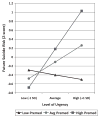Testing the relations between impulsivity-related traits, suicidality, and nonsuicidal self-injury: a test of the incremental validity of the UPPS model
- PMID: 21833346
- PMCID: PMC3152436
- DOI: 10.1037/a0019978
Testing the relations between impulsivity-related traits, suicidality, and nonsuicidal self-injury: a test of the incremental validity of the UPPS model
Abstract
Borderline personality disorder (BPD) has received significant attention as a predictor of suicidal behavior (SB) and nonsuicidal self-injury (NSSI). Despite significant promise, trait impulsivity has received less attention. Understanding the relations between impulsivity and SB and NSSI is confounded, unfortunately, by the heterogeneous nature of impulsivity. This study examined the relations among 4 personality pathways to impulsive behavior studied via the UPPS model of impulsivity and SB and NSSI in a residential sample of drug abusers (N = 76). In this study, we tested whether these 4 impulsivity-related traits (i.e., Negative Urgency, Sensation Seeking, Lack of Premeditation, and Lack of Perseverance) provide incremental validity in the statistical prediction of SB and NSSI above and beyond BPD; they do. We also tested whether BPD symptoms provide incremental validity in the prediction of SB and NSSI above and beyond these impulsivity-related traits; they do not. In addition to the main effects of Lack of Premeditation and Negative Urgency, we found evidence of a robust interaction between these 2 personality traits. The current results argue strongly for the consideration of these 2 impulsivity-related domains--alone and in interaction--when attempting to understand and predict SB and NSSI.
Keywords: UPPS; impulsivity; premeditation; suicidal behavior; urgency.
Figures
Similar articles
-
Negative Urgency and Lack of Perseverance: Identification of Differential Pathways of Onset and Maintenance Risk in the Longitudinal Prediction of Nonsuicidal Self-Injury.Behav Ther. 2015 Jul;46(4):439-48. doi: 10.1016/j.beth.2015.03.002. Epub 2015 Mar 11. Behav Ther. 2015. PMID: 26163709 Free PMC article.
-
A multimethod analysis of impulsivity in nonsuicidal self-injury.Personal Disord. 2010 Jan;1(1):67-75. doi: 10.1037/a0017427. Personal Disord. 2010. PMID: 22448604
-
Brief report: relationships between facets of impulsivity and borderline personality features.J Pers Disord. 2013 Aug;27(4):547-52. doi: 10.1521/pedi_2012_26_044. Epub 2012 Sep 17. J Pers Disord. 2013. PMID: 22984862
-
Self-harm in the context of borderline personality disorder.Curr Opin Psychol. 2021 Feb;37:139-144. doi: 10.1016/j.copsyc.2020.12.007. Epub 2021 Jan 6. Curr Opin Psychol. 2021. PMID: 33548678 Review.
-
Impulsivity and nonsuicidal self-injury: A review and meta-analysis.Clin Psychol Rev. 2015 Jun;38:13-24. doi: 10.1016/j.cpr.2015.02.010. Epub 2015 Mar 7. Clin Psychol Rev. 2015. PMID: 25779460 Review.
Cited by
-
Alcohol use, depressive symptoms, and impulsivity as risk factors for suicide proneness among college students.J Affect Disord. 2013 Jul;149(1-3):326-34. doi: 10.1016/j.jad.2013.01.046. Epub 2013 Mar 7. J Affect Disord. 2013. PMID: 23474093 Free PMC article.
-
Suicidality in Bipolar Disorder: The Role of Emotion-Triggered Impulsivity.Suicide Life Threat Behav. 2017 Apr;47(2):177-192. doi: 10.1111/sltb.12274. Epub 2016 Jul 13. Suicide Life Threat Behav. 2017. PMID: 27406282 Free PMC article.
-
Impulsivity and reasons for living among African American youth: a risk-protection framework of suicidal ideation.Int J Environ Res Public Health. 2015 May 15;12(5):5196-214. doi: 10.3390/ijerph120505196. Int J Environ Res Public Health. 2015. PMID: 25988310 Free PMC article.
-
Impulsive Responses to Positive and Negative Emotions: Parallel Neurocognitive Correlates and Their Implications.Biol Psychiatry. 2020 Feb 15;87(4):338-349. doi: 10.1016/j.biopsych.2019.08.018. Epub 2019 Aug 30. Biol Psychiatry. 2020. PMID: 31668478 Free PMC article. Review.
-
Impulsivity and self-harm in adolescence: a systematic review.Eur Child Adolesc Psychiatry. 2017 Apr;26(4):387-402. doi: 10.1007/s00787-016-0915-5. Epub 2016 Nov 5. Eur Child Adolesc Psychiatry. 2017. PMID: 27815757 Free PMC article.
References
-
- Aiken LS, West SG. Multiple regression: Testing and interpreting interactions. Thousand Oaks, CA: Sage; 1991.
-
- Anestis MD, Selby EA, Fink EL, Joiner TE. The multifaceted role of distress tolerance in dysregulated eating behaviors. International Journal of Eating Disorders. 2007;40:718–726. - PubMed
-
- Baumeister RF. Suicide as escape from self. Psychological Review. 1990;97:90–113. - PubMed
-
- Brezo J, Paris J, Turecki G. Personality traits as correlates of suicidal ideation, suicide attempts, and suicide completions: A systematic review. Acta Psychiatrica Scandinavica. 2006;113:180–206. - PubMed
-
- Costa PT, Jr, McCrae RR. Revised NEO Personality Inventory manual. Odessa, FL: Psychological Assessment Resources; 1992.
Publication types
MeSH terms
Grants and funding
LinkOut - more resources
Full Text Sources
Medical

